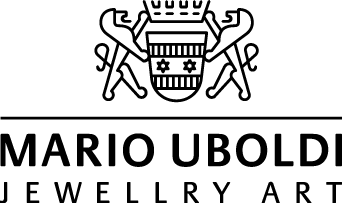Our world
The story of MARIO UBOLDI Jewellery Art began as a son’s token of joys, presented to his mother facing a disheartening life challenge. With time, these gifts of love took on an uplifting dynamic of their own until MARIO UBOLDI Jewellery Art was ultimately born.
MARIO UBOLDI Jewellery Art is named in honour of the original muse, a born Uboldi; Mario is her father and the designer’s grandfather.
The house of Uboldi is a noble family that traces back to the state of Milan in 12th century pre-Italy. The Lombard clan first denoted itself as leaders in trade, as early as 1198. It was later bestowed nobility rank by papal decree. Its coat of arms shows in the MARIO UBOLDI Jewellery Art brand.

Grandfather, mother and great grandmother of founder of Mario Uboldi Jewellery Art
MARIO UBOLDI Jewellery Art is an articulation, part of a larger language in contemporary design with cultural inflection that is applicable to different trades and to different scales. The designer’s approach focuses on analyzing phenomena in art, culture, nature and architecture and distills them to their core parameters to get at their underlying principles. By combining diverse attributes, such as historic and contemporary characteristics, a new visual dialogue emerges which is rooted in its references.
André C. Meyerhans, the founder and designer of MARIO UBOLDI Jewellery Art, is an award-winning architect who has been named one of the twenty-five most influential architects in the MENA region by Middle Eastern Architect magazine in 2015, 2016 and 2017. André is also an artist who's work and installations are part of public and private collections in Europe, Middle East and Asia. His creations blur traditional boundaries between art, architecture and design. André's work can be discovered on the respective websites for art and architecture. 
The early jewelry pieces created by André C. Meyerhans for his mother often evolved around an antique artifact - like architecture develops in reaction to its surrounding - accompanied by a design story that is as captivating as the final creation.
Below examples illustrate parts of the journey from the first piece of jewelry to the point of inception of Mario Uboldi Jewellery Art.
Ice Princess
The acrylic glass setting follows and underlines the shapes of the cut and broken aquamarine stones. While the setting contrasts the gemstone with its industrial origin in regards of material, it enhances the icy-clear appearance of it. (aquamarine cut and broken, and acrylic glass brushed finish)

Spinning Disk
The multi-functional, minimal setting is formally independent yet subordinate to the African artifact. It allows to display the center pieces in various ways, which changes the characteristics of the whole composition.
Bronze disk bead from the Baule tribe in Ivory Coast, dating back to 19th century, and 18k white gold matt finish


Look Lock
The lock of this necklace has been staged to the sculptural extreme to form the eye-catching piece. The shape of the golden disks grow out of the coral beads only to develop their own language. The difference in surface structure has been enhanced to increase the contrasting effect. The lock can be closed in three different ways.
Red coral bead necklace from Sri Lanka, dating back to 20th century, and 18k yellow gold polished and matt finish
Fire & Ice
These free-form objects of sculptural dimension explore the limits of materialization through the use of light. While the outside remains visually cool, the inside blazes in the sunlight like a beacon, flaring through the openings and dissolving the actual object.
18k white gold matt finish and 18k yellow gold polished finish
Little Red Riding Bead
The red stone bead floats above a concave disc of almost 10cm diameter. The intense red harmonizes with the warmth of the gold. Depending on the perspective, the stone appears as a red dot in a golden ground or the entire disk inflames in red, mirroring the bead.
Red stone bead from the Bactria-Margiana Archaeological Complex, dating back to 2000 B.C., and 18k yellow gold matt and polished finish
Bend-It Ring
A group of protective eye beads is raised above the ring in a Bauhaus-like arrangement. This ring is part of a larger design investigation: by cutting and bending parts out of a plane, something new is created without any waste. As all elements are part of the same original sheet, the resulting objects are always harmonious in itself.
Protective eye beads made of glass from the Mediterranean litoral (Syria), dating back to 4th-3rd century B.C., and 18k white gold matt and polished finish
The Little Prince’s Planet
Referring to the Saint-Exupéry’s famous novella, this unique piece is about dialogues and discoveries – of the new and the old, of the heavy and the light, of the known and the unknown. The combination between different characteristics of density, size and surface qualities evokes an inspiring conversation. The focal point lies on a filigree, sphere-like sculpture placed off-centric in a string of solid fossilised bone bead from Java, Indonesia. The petrified pellets date back to the Triassic to Cretaceous period which gives them an age of approximately 250 million years.
18k white gold polished finish and petrified dinosaur bone beads

MARIO UBOLDI Jewellery Art is a trademark registered in Switzerland.

